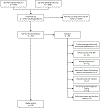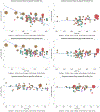Incidence of Dementia and Alzheimer Disease Over Time: A Meta-Analysis
- PMID: 31220336
- PMCID: PMC6612587
- DOI: 10.1111/jgs.16027
Incidence of Dementia and Alzheimer Disease Over Time: A Meta-Analysis
Abstract
Background/objectives: Population-based incidence estimates of dementia and Alzheimer disease (AD) provide important information for public health policy and resource allocation. We conducted a meta-analysis of published studies that reported age-specific incidence rates of dementia and AD to determine whether dementia and AD incidence rates are changing over time.
Design: PubMed and MEDLINE were searched for publications through June 30, 2017, using key words "dementia", "Alzheimer", and "incidence." Inclusion criteria for the meta-analysis are: (1) population-based studies using personal interviews and direct examinations of the study subjects, (2) standardized clinical diagnosis criteria, (3) reporting age-specific incidence rates, (4) published in English, and (5) sample size of 500 or greater and length of follow-up of 2 years or greater. Mixed-effects models were used to determine the association between birth year and incidence rates.
Measurements: Age-specific dementia/AD incidence rates and their standard errors reported in each study.
Results: Thirty-eight articles with 53 cohorts on dementia incidence and 31 articles with 35 cohorts on AD incidence met the inclusion criteria. There were significant associations between later birth years and decreased dementia incidence rates in all three age groups (65-74, 75-84, and 85 years and older). There were no significant associations between birth year and AD incident rates in any of the three age groups. In particular, AD incidence rates reported from Western countries stayed steady in all age groups, while studies in non-Western countries showed significantly increased AD incidence rates for the 65 to 74 years age group (odds ratio = 2.78; P = .04), but a nonsignificant association for the 75 to 84 or 85 years and older groups.
Conclusion: Dementia incidence declined over the past four decades, but AD incidence did not decline. Further research, especially from non-Western countries, is needed to elucidate the mechanism underlying the trends in dementia and AD incidence over time.
Keywords: Alzheimer disease; dementia; incidence; trend.
© 2019 The American Geriatrics Society.
Conflict of interest statement
Conflict of Interest: The authors have no conflicts of interest.
Figures



Comment in
-
The Importance of Birth Year for the Incidence of Dementia.J Am Geriatr Soc. 2019 Jul;67(7):1330-1332. doi: 10.1111/jgs.16029. Epub 2019 Jun 20. J Am Geriatr Soc. 2019. PMID: 31220335 No abstract available.
Similar articles
-
The relationships between age, sex, and the incidence of dementia and Alzheimer disease: a meta-analysis.Arch Gen Psychiatry. 1998 Sep;55(9):809-15. doi: 10.1001/archpsyc.55.9.809. Arch Gen Psychiatry. 1998. PMID: 9736007
-
Dementia and Alzheimer disease incidence: a prospective cohort study.Arch Neurol. 2002 Nov;59(11):1737-46. doi: 10.1001/archneur.59.11.1737. Arch Neurol. 2002. PMID: 12433261
-
Dementia and Alzheimer disease incidence rates do not vary by sex in Rochester, Minn.Arch Neurol. 2002 Oct;59(10):1589-93. doi: 10.1001/archneur.59.10.1589. Arch Neurol. 2002. PMID: 12374497
-
[Prevalence and incidence of dementia among the very old. Review of the literature].Rev Epidemiol Sante Publique. 2003 Jun;51(3):349-60. Rev Epidemiol Sante Publique. 2003. PMID: 13130215 Review. French.
-
Prevalence of dementia in the People's Republic of China from 1985 to 2015: a systematic review and meta-regression analysis.BMC Public Health. 2019 May 15;19(1):578. doi: 10.1186/s12889-019-6840-z. BMC Public Health. 2019. PMID: 31092218 Free PMC article.
Cited by
-
Temporal Dementia and Cognitive Impairment Trends in the Very Old in the 21st Century.J Alzheimers Dis. 2023;93(1):61-74. doi: 10.3233/JAD-220915. J Alzheimers Dis. 2023. PMID: 36938733 Free PMC article.
-
Effect of 1 Year of Qigong Exercise on Cognitive Function Among Older Chinese Adults at Risk of Cognitive Decline: A Cluster Randomized Controlled Trial.Front Psychol. 2020 Oct 30;11:546834. doi: 10.3389/fpsyg.2020.546834. eCollection 2020. Front Psychol. 2020. PMID: 33192794 Free PMC article.
-
Heart Disease and Stroke Statistics-2023 Update: A Report From the American Heart Association.Circulation. 2023 Feb 21;147(8):e93-e621. doi: 10.1161/CIR.0000000000001123. Epub 2023 Jan 25. Circulation. 2023. PMID: 36695182 Free PMC article. Review.
-
Estimating the incidence of dementia in New Zealand: a cohort study applying capture-recapture modelling to routinely collected linked health datasets.Lancet Reg Health West Pac. 2024 Oct 21;52:101216. doi: 10.1016/j.lanwpc.2024.101216. eCollection 2024 Nov. Lancet Reg Health West Pac. 2024. PMID: 39502411 Free PMC article.
-
Dementia and Related Comorbidities in the Population Aged 90 and Over in the Vitality 90+ Study, Finland: Patterns and Trends From 2001 to 2018.J Aging Health. 2023 Jun;35(5-6):370-382. doi: 10.1177/08982643221123451. Epub 2022 Oct 18. J Aging Health. 2023. PMID: 36256914 Free PMC article.
References
-
- Brookmeyer R, Johnson E, Ziegler-Graham K, Arrighi HM. Forecasting the global burden of Alzheimer’s disease. Alzheimers Dement . July 2007;3(3):186–191. - PubMed
-
- Schrijvers EM, Verhaaren BF, Koudstaal PJ, Hofman A, Ikram MA, Breteler MM. Is dementia incidence declining?: Trends in dementia incidence since 1990 in the Rotterdam Study. Neurology. May 08 2012;78(19):1456–1463. - PubMed
Publication types
MeSH terms
Grants and funding
LinkOut - more resources
Full Text Sources
Medical
Miscellaneous

